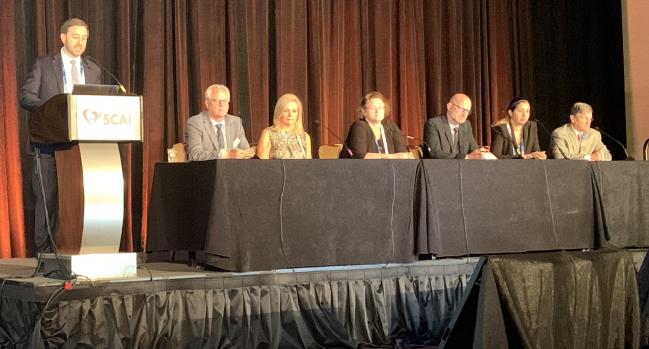SAFE-PAD Provides More Long-term Safety Data for Paclitaxel
With 5-year follow-up on more than 32,000 patients, researchers are asking what the FDA still needs to quell safety concerns.

ATLANTA, GA—Ongoing long-term follow-up of Medicare patients who received paclitaxel-coated devices for the treatment of PAD continues to show no evidence of an increased risk of death compared with uncoated balloons or stents, updated results from the SAFE-PAD study show.
After accounting for differences between treatment groups, mortality was 63.6% with uncoated devices versus 62.5% with paclitaxel-coated devices (HR 0.98; 95% CI 0.96-0.99) at a median of 3.5 years, with some patients followed out to more than 6 years.
In his presentation here at the Society for Cardiovascular Angiography and Interventions (SCAI) 2022 Scientific Sessions, Eric A. Secemsky, MD (Beth Israel Deaconess Medical Center, Boston, MA), added that the results were consistent in key prespecified subgroups, including those with lower mortality risks. The US Food and Drug Administration continues to recommend that paclitaxel-coated devices for PAD only be used in patients at high risk for restenosis and repeat interventions and has not updated that guidance since August 2019.
“We now have a number of prospective randomized trial data, subanalyses of trials, and observational data, and we've yet to be able to replicate the harm associated with paclitaxel in any of the subsequent studies that have come out since [the Katsanos meta-analysis],” Secemsky said.
The 2018 meta-analysis of RCTs led by Konstantinos Katsanos, MD, PhD (Patras University Hospital, Rion, Greece), found a late mortality increase beginning at 2 to 3 years in patients treated with a paclitaxel-based DES or drug-coated balloon (DCB) compared with a plain balloon or plain stent and a 7% estimation of increased absolute risk at 4-5 years. The new SAFE-PAD data therefore support noninferiority for survival between treatment groups at the time points thought to be associated with the greatest risk.
It was discovered in the aftermath of the meta-analysis’ publication that up to 30% of 5-year mortality data from the RCTs had been lost to follow-up, partly because the studies were not designed to track long-term mortality. As those data were recovered, the mortality picture changed and the safety signal weakened. Secemsky’s group has added to those efforts with SAFE-PAD, a planned seven-report series on paclitaxel mortality in the Medicare population.
“If you look at the original Katsanos meta-analysis, only about 800 to 1,000 patients were included in the 4- to 5-year mortality group, and we now have over 32,000 patients with 5-year data in SAFE-PAD,” he told TCTMD.
The latest SAFE-PAD report, which was simultaneously published as a research letter in Circulation: Cardiovascular Interventions, also shows that the primary outcome data remain robust in both instrumental variable analysis and falsification endpoint analysis.
What is FDA Waiting for?
“It's clear that a randomized trial is not going to happen, so it doesn't seem like the data can get any better than what you just presented,” panelist Herbert D. Aronow, MD (Henry Ford Health, Detroit, MI), commented in the session. He called the latest analysis “sophisticated” and “convincing.”
Noting that atherectomy was used in 43% of the drug-coated devices patients, session co-moderator Cindy L. Grines, MD (Northside Hospital Cardiovascular Institute, Johns Creek, GA), said “the fact that you have a zero difference in mortality despite these presumed higher-risk features is very, very good.”
I think many of us would love to be able to bring patients to conversations with the FDA and regulatory bodies about why these devices make a difference. Eric A. Secemsky
The big question, as all agreed, is what more the FDA needs to lift its restrictions. In addition to the slew of data refuting the mortality signal of the Katsanos meta-analysis, Secemsky said the use of paclitaxel-coated devices has reverted back to much the same rate it was before the controversy, but with the addition of seeking patient consent to specifically acknowledge that the FDA considers paclitaxel a safety risk. Despite the agency’s concerns, a new paclitaxel-coated device, the Ranger DCB (Boston Scientific) hit the market in the middle of the paclitaxel melee in 2020, suggesting the agency has some level of comfort with the use of these devices.
In January 2021, FDA advisors issued a rare comment on the publication of an unplanned interim analysis from the SWEDEPAD trial, which showed no difference in all-cause mortality at a mean of 2.5 years between PAD patients treated with coated versus uncoated devices, regardless of the extent of limb disease. According to the FDA, the results were “comforting,” but limited.
“I think they are still waiting for one other piece of data, which is a more updated patient-level meta-analysis that some of the industry partners are sponsoring,” Secemsky said. “Some of the pressure may have to come from us. It's going to have to come from SCAI and some of the other societies.”
The bottom line, he added, is that the language added by the FDA acknowledging risk of paclitaxel use leaves clinicians feeling vulnerable and unclear about how to convey risk accurately. To TCTMD, Secemsky said patient voices are crucial, particularly those of PAD patients who often have limited options to improve or maintain their limb.
“I think many of us would love to be able to bring patients to conversations with the FDA and regulatory bodies about why these devices make a difference,” he observed. Going back to the data, he said it seems inevitable from the work that has been done so far, that when all is said and done, paclitaxel treatment will be associated with a risk estimate far lower than the 7% over 5 years suggested by the Katsanos meta-analysis—perhaps closer to 2% or less over 5 years.
“That's where the patient’s voice is important,” he concluded. “If we get to the point where we can present data like that, which everyone agrees on, then patients can make a decision based on their understanding of that marginal risk.”
L.A. McKeown is a Senior Medical Journalist for TCTMD, the Section Editor of CV Team Forum, and Senior Medical…
Read Full BioSources
Secemsky EA, Song Y, Schermerhorn M, et al. Update from the longitudinal assessment of safety of femoropopliteal endovascular treatment with paclitaxel-coated devices among Medicare beneficiaries: the SAFE-PAD study. Circ Cardiovasc Interv. 2022;15:e012074.
Disclosures
- Secemsky reports consulting/speakers board for Abbott, Bayer, BD, Boston Scientific, Cook, CSI, Endovascular Engineering, Medtronic, and Philips; And grants to institution from BD, Boston Scientific, Cook, Laminate Medical, Medtronic, and Philips.





Comments